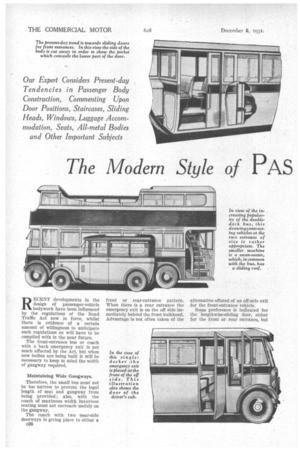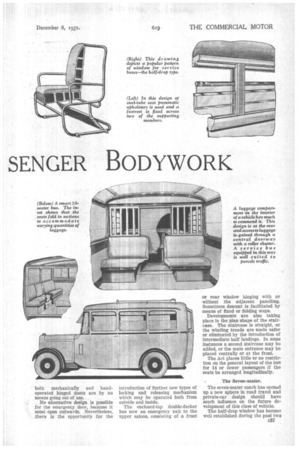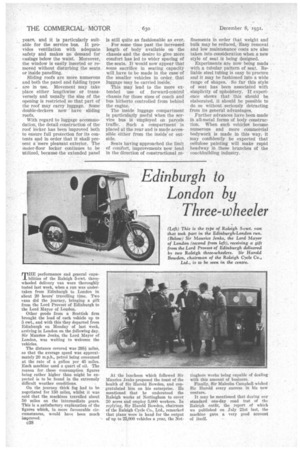The Modern Style of PAS
Page 58

Page 59

Page 60

If you've noticed an error in this article please click here to report it so we can fix it.
SENGER BODYWORK
Our Expert Considers Present-day Tendencies in Passenger Body Construction, Commenting Upon Door Positions, Staircases, Sliding Heads, Windows, Luggage Accommodation, Seats, All-metal Bodies and Other Important Subjects
RECENT developments in the design of passenger-vehicle bodywork have been influenced by the regulations of the Road Traffic Act now in force, whilst there is evidence of a certain amount of willingness to anticipate such regulations as will have to be complied with in the near future.
The front-entrance bus or coach with a back emergency exit is not much affected by the Act, but when new bodies are being built it will be necessary to keep in mind the width of gangway required.
Maintaining Wide Gangways.
Therefore, the small bus must not be too narrow to prevent the legal length of seat and gangway from being provided ; also, with the coach of maximum width luxurious seating must not encroach unduly on the gangway.
The coach with two near-side doorways is giving place to either a c36 front or rear-entrance pattern. When there is a rear entrance the emergency exit is on the off side immediately behind the front bulkhead. Advantage is not often taken of the alternative offered of an off-side exit for the front-entrance vehicle.
Some preference is indicated for the lengthwise-sliding door, either for the front or rear entrance, but both mechanically and handoperated hinged doors are by no means going out of use.
No alternative design is possible for the emergency door, because it must open outwards. Nevertheless, there is the opportunity for the introduction of further new types of locking and releasing mechanism which may be operated both from outside and inside.
The enclosed-top double-decker has now an emergency exit to the upper saloon, consisting of a front or rear window hinging with or without the adjacent panelling. Sometimes descent is facilitated by means of fixed or folding steps.
Developments are also taking place in the plan shape of the staircase. The staircase is straight, or the winding treads are made safer or eliminated by the introduction of Intermediate half landings. In some Instances a second staircase may be added, or the main entrance may be placed centrally or at the front.
The Act places little nr no restriction on the general layout of the bus for 14 or fewer passengers if the seats be arranged longitudinally.
The Seven-seater.
The seven-seater coach has opened up a new sphere in road travel and private-car design should have much influence on the future development of this class of vehicle.
The half-drop window has become well established during the past two years, and it is particularly suitable for the service bus. It provides ventilation with adequate safety and makes no demand for casings below the waist. Moreover, the window is easily inserted or removed without disturbing the seats or inside panelling.
Sliding roofs are more numerous and both the panel and folding types are in use. Movement may take place either lengthwise or transversely and usually the size of the opening is restricted so that part of the roof may carry luggage. Some double-deckers now have sliding roofs.
With regard to luggage accommodation, the detail construction of the roof locker has been improved both to ensure full protection for its contents apd in order that it shall present a mere pleasant exterior. The under-floor locker continues to be utilized, because the extended panel is still quite as fashionable as ever.
For some time past the increased length of body available on the chassis and the desire to give more comfort has led to wider spacing of the seats. It would now appear that some sacrifice in seating capacity will have to be made in the case of the smaller vehicles in order that luggage may be carried inside.
This may lead to the more extended use of forward-control chassis for those sizes of coach and bus hitherto controlled from behind the engine.
The inside luggage compartment is particularly useful when the service bus is employed on parcels traffic. Such a compartment is placed at the rear and is made accessible either from the inside-or outside.
Seats having approached the limit of comfort, improvements now tend in the direction of constructional re
finements in order that weight and bulk may be reduced. Easy removal and low maintenance costs are also taken into consideration when_a new style of seat is being designed.
Experiments are now being made with a tubular pattern of seat. Reliable steel tubing is easy to procure and it may be fashioned into a wide range of shapes. So far this style of seat has been associated with . simplicity of upholstery. If experience shows that this should be elaborated, it should be possible to do so without seriously detracting from its general advantages.
Further advances have been made in all-metal forms of body construction. When such vehicles become numerous and more commercial bodywork is made in this way, it may confidently be expected that cellulose painting will make rapid headway in these branches of the coachbuilding industry.














































































































